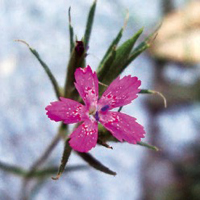[Vascular spontaneous flora of the town of Modena: analysis of the historic centre]

Accepted: 19 June 2020
All claims expressed in this article are solely those of the authors and do not necessarily represent those of their affiliated organizations, or those of the publisher, the editors and the reviewers. Any product that may be evaluated in this article or claim that may be made by its manufacturer is not guaranteed or endorsed by the publisher.
Authors
[The results of the first systematic study concerning the urban flora of Modena are here presented. Data collection was carried out in 2014-2018, by inspecting every road and square of the historic centre, intended as the area encompassed within the wide avenues that retrace the layout of the 16th century ramparts. 344 plant species were found, of which 1 is new for the flora of Italy, 10 are new for Emilia-Romagna and 19 are new for the province of Modena. Among these 30 new species, alien species make up 63%. There are 17 species no longer found during this study, which were observed at least 20 years ago or were testified only by late 19th century herbarium samples. The life form spectrum is dominated by the therophytes (44%), followed by hemicryptophytes (28%) and phanerophytes (15%). Eurasian (28%), Mediterranean (24%) and cosmopolite species (24%) dominate the chorological spectrum. Neophytes are 18% of the total number of species, quite a low percentage if compared with what was observed in other towns of the Po Plain and Central Europe. This fact is probably due to the small area of the historic city centre, whose compact urbanistic structure seems to resist against the diffusion of alien plants. The invasive species are 11% of the total. The presence of 15 hygrophilous species is interesting, since they indicate irrigation or hyper-irrigation of lawns and flowerbeds. We found 4 protected species at the regional level, of which 2 are escaped from cultivation. Concerning the affinity of the species to urban ecology, the floristic list is dominated by the urban-neutral (45%) and urbanophilous species (42%). This fact can indicate a good variety in terms of growth environments, with most of them probably in a quite advanced phase of ecological evolution for an urban centre, and also a fairly good environmental quality, likely due – at least partially – to the abundance of green areas. The species richness in every road or square is strongly correlated to the environmental heterogeneity (ρ = 0,794) and moderately correlated to the nearby presence of green areas (ρ = 0,544) and to the road length or square surface (ρ = 0,665 and 0,673, respectively). Furthermore, a weak correlation (ρ = 0,212) exists between the presence of horticultural or food species and the presence of restaurants in the same road or square. Therefore, the town is confirmed to be a very dynamic ecosystem with great biological richness, useful to understand the ecological strategies developed by plants to adapt to sometimes very unfavourable conditions. In addition, during the process of colonisation of a region, urban areas often act as a «hub» for the spreading of species along the road and railway network. Understanding and respecting the ecological roles of native species is thus fundamental for modern urban planning, aimed at improving the quality of life as a whole.]
[Article in Italian]
How to Cite
PAGEPress has chosen to apply the Creative Commons Attribution NonCommercial 4.0 International License (CC BY-NC 4.0) to all manuscripts to be published.
Similar Articles
- Filip Verloove, Nicola Ardenghi, New distributional records of non-native vascular plants in northern Italy , Natural History Sciences: Vol. 2 No. 1 (2015)
- Carlo M. Biancardi, Valentina Rigo, Sonia Azzolini, Claudio Gnoli, Eurasian badger (meles meles) habitat and sett site selection in the northern Apennines , Natural History Sciences: Vol. 1 No. 1 (2014)
- Alessandro Garassino, Giovanni Pasini, A new squat lobster (Crustacea, Anomura, Munididae) from the Pliocene of Monterotondo Marittimo (Tuscany, Italy) , Natural History Sciences: Vol. 2 No. 1 (2015)
- Enrico Banfi, Fabrizio Bartolucci, Jean-Marc Tison, Gabriele Galasso, A new genus for Papaver sect. Meconella and new combinations in Roemeria (Papaveraceae) in Europe and the Mediterranean area , Natural History Sciences: Vol. 9 No. 1 (2022)
- Alessandro Nardotto, Cristian Bertolin, Camera traps equipped with macro lenses as a tool for monitoring arboreal small mammals: a case study in an agroecosystem (NE Italy) , Natural History Sciences: Vol. 11 No. 2 (2024)
- Agostino Brusco, Roberto Marchianò, Giuseppe Dodaro, Corrado Battisti, Non-volant mammals of the ‘Lago di Tarsia’ Regional Nature Reserve and Special Conservation Area (IT93100055; Cosenza, Southern Italy) , Natural History Sciences: Vol. 9 No. 2 (2022)
- Laura Farina, Notes on Longitarsus aphthonoides Weise 1887 and on the species groups of L. lateripunctatus (Rosenhauer 1856) and L. curtus (Allard 1860) (Coleoptera, Chrysomelidae) , Natural History Sciences: Vol. 8 No. 2 (2021)
- Milo Manica, Lorenzo Laddaga, New records of Austropotamobius pallipes (Decapoda: Astacidae) relict populations from the Ticino River , Natural History Sciences: Vol. 10 No. 1 (2023)
- Enrico Schifani, First report of underwater oviposition by the island bluetail damselfly, Ischnura genei (Zygoptera, Coenagrionidae) , Natural History Sciences: Vol. 9 No. 1 (2022)
- Paolo Galasso, Giovanni Spinella, Manuel Andrea Zafarana, Antonino Barbera, Andrea Cusmano, Giovanni Cumbo, Davide D'Amico, Dario Grimaldi, Renzo Ientile, Francesco La Spina, Davide Pepi, Antonino Torre, Giancarlo Torre, Salvatore Surdo, Status, distribution and conservation of Kentish plover Charadrius alexandrinus (Aves, Charadriiformes) in Sicily , Natural History Sciences: Vol. 9 No. 1 (2022)
<< < 6 7 8 9 10 11 12 13 14 15 > >>
You may also start an advanced similarity search for this article.


 https://doi.org/10.4081/nhs.2020.443
https://doi.org/10.4081/nhs.2020.443






